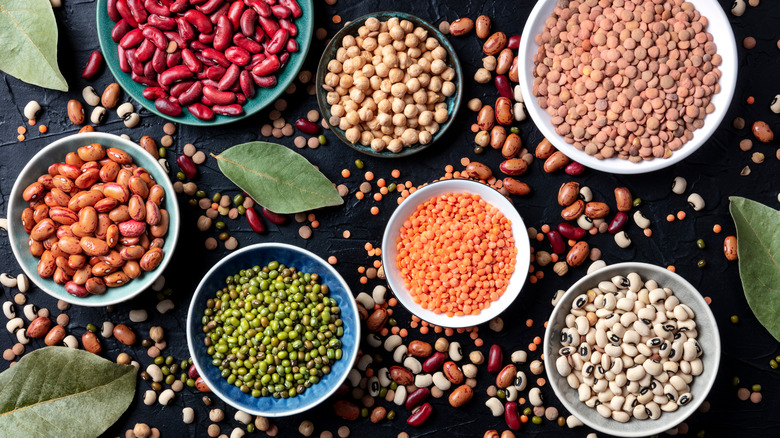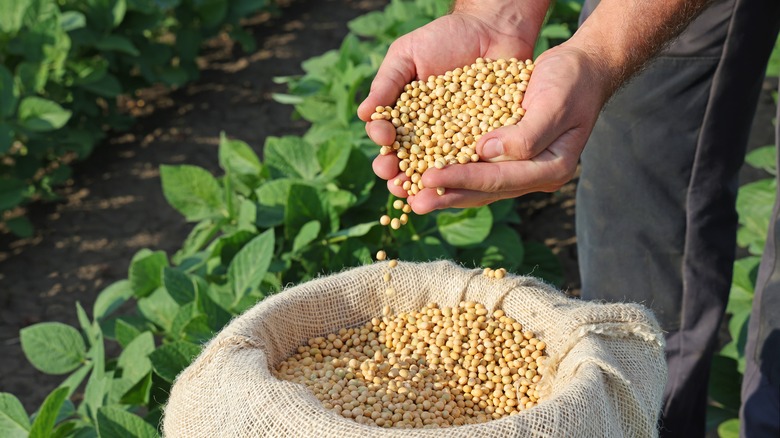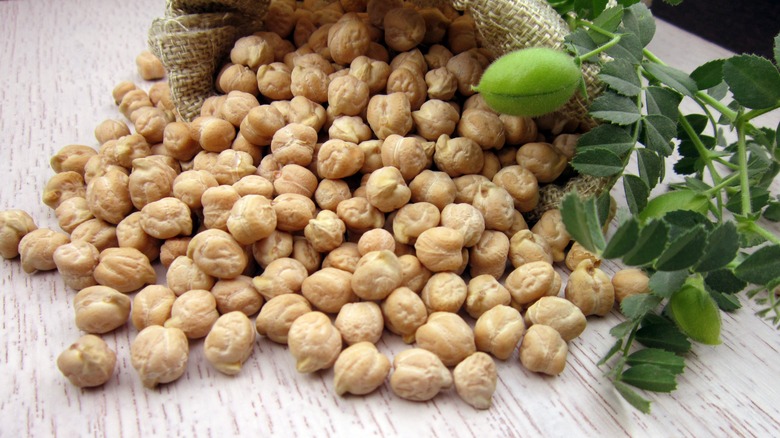Chickpea Vs. Soybean: The Differences Between The Twin Legumes
Both soybeans and chickpeas deserve a lot of legume love from those seeking an easy and affordable dietary protein boost. As plant-based food components in a wide range of recipes, they appeal to those with meat-restricted meal plans but also to anyone loving a light, nutrition-packed addition to salads, soups, appetizers, dips, spreads, and way more.
However, the twin blondie legumes have notable differences, including how they're presented and consumed. But they definitely share family characteristics when it comes to impressive nutrient values. B vitamins live mightily in both soybeans and chickpeas, though in varying amounts, with vitamins C, E, and K not far behind on the nutrition scale. They also share powerful pockets of zinc, iron, and magnesium, with substantial claimed impacts on human health, especially for those adhering to vegan diets.
Both march front and center in the protein parade, but one has a much broader reach, with almost double the amount of protein per gram. Considerable differences also exist in carbs, minerals, fat, sugar, and fiber content.
Even more notable for daily eating are the contrasting ways in which soybeans and chickpeas get incorporated into recipes, snacks, and meal planning. After all, if they don't taste good, those nuanced and prolific health benefits go sadly to waste.
Soybeans, nutrients, and how to use
You don't often see straight soybeans listed on menus, but a version of them almost certainly sounds familiar. Edamame, which are green "vegetable" soybeans, have risen in the Western culinary world, most often showing up as an appetizer or snack.
Scientifically known as Glycine max, soybeans have been around for many centuries. Potentially dating back to ancient China, the green vegetable variety became part of Japanese diets by the 1200s, where the name "edamame" translates roughly as "beans on branches."
The young beans are typically boiled for about six minutes or steamed for three to eight minutes in salted water, inside the pod, and eaten fresh either as-is or with added oils, vinegar, or seasonings such as garlic and parmesan. After cooling slightly, just squeeze the beans out and pop them straight from the shell pods into your mouth. The shells are not edible, and the beans cannot be consumed raw due to negative digestive effects.
Some chefs also use edamame soybeans for adding protein to soups, stir-fries, salads, noodles, and sushi, or in crushed form as a crust on fish or poultry. They also work well in soy sauces and when blended into hummus spreads, dips, or tossed into a salsa mix or egg-and-veggie scramble.
Soybeans contain considerably more protein than chickpeas, harboring about 36 grams of protein per 100 grams of raw soy. They have roughly half the carbohydrates of chickpeas and less sugar –– but chickpeas carry more nutritional value in other areas.
Chickpeas, uses, and nutritional info
Chickpeas, known scientifically as Cicer arietinum, also go by their Spanish moniker of garbanzo beans. These soft, round legumes made their way to worldwide fame via the Middle East and Mediterranean regions, reflected in dishes such as curries, falafels, and now-mainstream hummus spreads.
They're also a central ingredient in Indian cooking, where the crops are prolifically produced for domestic use and exports. In India, chickpeas are often dried and ground into powder-like flour, used to create daal or stewed masala dishes.
In the U.S., chickpeas show up as pizza crust, a filler for sandwich wraps, fried in a waffle iron, whipped into vegan meringues, tucked into casseroles, stews, and curries, or crisped, roasted, and flavored as a snack food. The paper-thin coating on chickpeas is easy to peel but is edible, so it's a matter of personal preference. Like soybeans, they cannot be eaten raw.
With the gentle texture and wallop of nutrients, just about anything goes when it comes to consuming cooked chickpeas. They contain 20 grams of protein per 100 grams of raw chickpeas, compared to the same amount of soybeans with 36 grams –- but it's still a considerably high protein value. Chickpeas are also powerhouses of dietary fiber, with 12 grams, three more than soybeans. And finally, chickpeas carry a third of the fat and a substantial collection of antioxidants.
Soybean and chickpea more than earn pantry space in any kitchen, for their shared versatility, health benefits, and relatively low cost.


